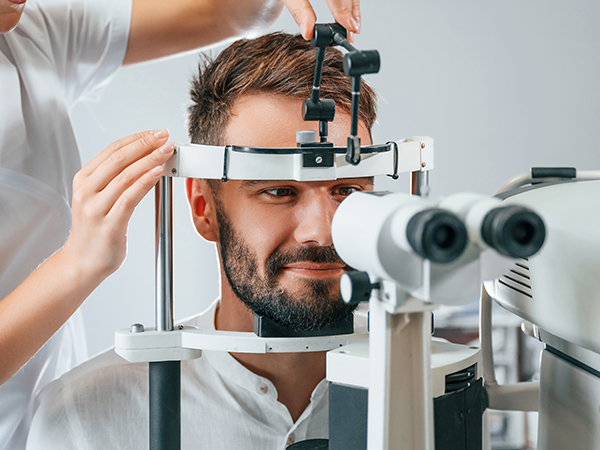
Dry Eye can have a major impact on your quality of life. You may find your eyes get tired faster or you have difficulty reading. Not to mention the discomfort of a burning sensation or blurry vision. Let’s take a look at dry eye treatments – from simple self-care to innovative prescriptions and therapies – to help you see clearly and comfortably.
What is Dry Eye?
Understanding dry eye will help you determine the best treatment option. Dry eye occurs when a person doesn't have enough quality tears to lubricate and nourish the eye. Tears reduce eye infections, wash away foreign matter, and keep the eye’s surface smooth and clear. People with dry eyes either do not produce enough tears or their tears are poor quality. It’s a common and often chronic problem, especially in older adults.
Preventive Self-Care
Before we delve into more serious dry eye treatment options, here are a few simple self-care options that can manage minor cases of dry eye.
Blink regularly when reading or staring at a computer screen for a long time.
Make sure there’s adequate humidity in the air at work and at home.
Wear sunglasses outside to reduce sun and wind exposure. Wraparound glasses are best.
Take supplements with essential fatty acids as these may decrease dry eye symptoms.
Drink 8 to 10 glasses of water each day to avoid dehydration.
Find out if any of your prescriptions have dry eye as a side effect and if so, see if you can take an alternative.
Artificial Tears
For mild cases of dry eyes, the best option is over-the-counter eye drops. Here are a few tips for selecting the right one:
Low viscosity – These artificial tears are watery. They often provide quick relief with little or no blurring of your vision, but their effect can be brief, and sometimes you must use these drops frequently to get adequate relief.
High viscosity – These are more gel-like and provide longer-lasting lubrication. However, these drops can cause significant blurring of your vision for several minutes. For this reason, high-viscosity artificial tears are recommended at bedtime.
Prescription Dry Eye Treatments
There are several prescriptions that treat dry eye differently. Your eye doctor can advise the best option for your situation.
Contact Lenses – There are specialty contact lenses that deliver moisture to the surface of the eye. They’re called scleral lenses or bandage lenses.
Antibiotics– If your eyelids are inflamed, this can prevent oil glands from secreting oil into your tears. Your doctor may recommend antibiotics to reduce inflammation.
Anti-inflammatory drugs – These are eye drops to control inflammation on the surface of your eyes (cornea) using the immune-suppressing medication cyclosporine (Restasis) or corticosteroids.
Eye Inserts – If artificial tears don't help, another option may be a tiny eye insert. Once a day, you place the hydroxypropyl cellulose (Lacrisert) insert between your lower eyelid and your eyeball. It dissolves slowly, releasing a substance to lubricate your eye.
Tear-stimulating drugs – Available as pills, gel or eye drops, cholinergic (pilocarpine, cevimeline), these help to increase tear production.
Autologous blood serum drops – For serious dry eye that’s not responding to other treatment, these eyedrops are made with a sample of your blood. It’s processed to remove the red blood cells and then mixed with a salt solution.

Dry Eye Procedures
Punctal Plugs – Tear ducts can be plugged with tiny silicone plugs to reduce tear loss. By partially or completely closing your tear ducts, it can keep your tears from leaving your eye too quickly.
Intense-Pulsed Therapy – This utilizes pulses of light to liquefy and release hardened oils that have clogged glands in the eyelids.
Optilight, Optilift and Radio Frequency - The benefits of optilight are reducing inflammation and getting to the root cause of dry eye and enhancing meibomian gland production. It also has esthetic benefits such as the ability to even out skin tone and texture, reduce fine lines and wrinkles. The optilift and radio frequency treatment heats the meibomian glands that produce the oils that lubricate the eye and improves tear film quality. The Optilift utilizes dynamic muscle stimulation to address lower lid laxity and impaired blinking which contributes to dry eye. It stimulates the periorbital muscles to improve eyelid function and tear retention. It also improves under eye bags and creates a more rested youthful appearance to the eyes.
We offer IPL (Intense-Pulsed Therapy)
During this procedure, gentle pulses of light are delivered to the skin adjacent to the eyes to reduce inflammation and eliminate excess bacteria. These pulses melt the thick secretions on the eyelids, release the buildup of oil and unclog the meibomian glands. It is also known as a “photofacial” and can improve the color (and sometime the texture) of your skin if you have signs of sun damage or age spots. IPL may also help if you have red, brown, or splotchy skin because of a health condition such as rosacea.
How many treatments are needed: typically 4 treatments spaced 2 weeks apart followed by a maintenance session roughly every 6 months.
OptiLift
OptiLift is a non-surgical treatment for lower eyelid laxity and impaired blinking, using dynamic muscle stimulation (DMSt) technology. It works by toning and strengthening the muscles around the eyes, improving eyelid function and tear film stability. The treatment aims to address both functional and aesthetic concerns related to aging and weakened periorbital muscles. Unlike treatments that only address symptoms, Optilift targets the weakened periorbital muscles, which are often the underlying cause of many eye problems. It's a non-surgical procedure with minimal discomfort and no need for recovery or post-treatment restrictions.
A typical treatment plan consists of 5 treatment spaced a week apart followed by a maintenance session every 3-6 months.
You don’t have to suffer from the symptoms of dry eye. Talk to your optometrist about dry eye treatment options designed to address the underlying cause of your condition.







